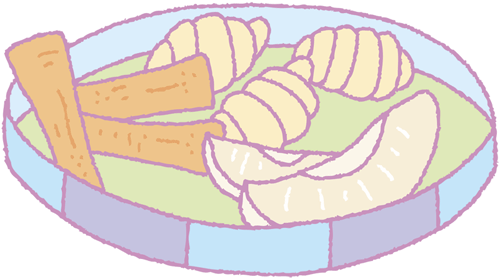Finger foods are a wonderful way to introduce your baby to various tastes and textures, and will help to encourage independent eating. Your baby will enjoy the process of feeding himself as well as the new variety of foods that you offer. The more you encourage this process, the easier the transition will be.
| Q: |
How do we progress from purées to lumps?
| | A: |
The simple answer is a little at a time. All babies develop at
different paces, but by now your baby should be a confident purée eater,
and will probably have mastered some finger foods. Not all babies find
the transition easy, and some actively avoid lumps for as long as they
can. Try to stay calm and work at your baby’s pace.
You can begin by
mashing rather than puréeing some of her favorite foods, as these will
be familiar to her, and she’ll find the process less daunting. You can
also try adding a few of her usual finger foods to her purées—some toast
fingers alongside her puréed vegetables, or some mini-pasta shapes
stirred into her broccoli with cheese. Let her get used to every stage
before rushing her on. You are much better off letting her explore
mashed foods for a few weeks before moving to finely chopped.
|
| Q: |
How can I tell if my baby is ready for finger foods?
| | A: |
There are two schools of thought about this one. Some people
believe that finger foods should be offered first, and in many cases
instead of purées. Others believe that purées should be offered first,
and when babies are developmentally ready to pick up, bite, chew, and
swallow finger foods, they can be offered—somewhere after nine months.
Personally, I think that there is no reason why the two approaches can’t
be combined. If your baby is a confident eater, offering a variety of
finger foods alongside purées is a good way to accustom him to different
textures and tastes, and also encourages him to learn the basics of
self-feeding. Babies naturally begin to pick things up and explore them,
inevitably putting them into their mouths, at around five or six
months. From this point on, offering food instead of a toy can provide a
nice introduction to the exciting world of food! Be careful what you
choose: your baby should be able to gnaw the food without choking or
gagging, and be able to derive enough taste by working on it with his
gums or budding teeth. Always supervise your baby when he is eating
finger food, no matter what his age.
|
| Q: |
How do I introduce finger foods?
| | A: |
I would suggest offering finger foods at every mealtime,
alongside your baby’s normal purées, but only after you have established
several different fruits, vegetables, and other foods that have been
successfully introduced, without any adverse reactions or effects. I’ve
also found that it’s useful to have a bowl with several different
compartments for holding a range of different finger foods.
Offering finger
foods does help to teach your baby to feed herself, and to increase her
food repertoire a little. If she picks something up and tastes it, she
may not like it to begin with or for the first few times she tries it,
but eventually she may consider it to be familiar enough to eat.
|
| Q: |
Which are the best first finger foods for my baby?
| | A: |
The very same finger foods that we suggested in the previous chapter are also appropriate here .
Go for easy-to-manage pieces of fruits (melon, apple, banana, kiwi
fruit), lightly steamed vegetables (carrot, broccoli, green beans),
little sandwiches with healthy fillings, rice cakes, small chunks of
cheese, hard-boiled eggs, healthy whole-grain breakfast cereals,
berries, dried fruits, well-cooked pasta shapes, toast fingers, and the
like. Choose brightly colored fruits for their enhanced nutritional
value, and whole wheat goodies over those that have been refined. You
can even offer foods such as my delicious fish goujons, chicken meatballs, without the sauce ), which your baby can taste, suck, and gnaw at, or pieces of chicken, which will serve the same purpose.
|
| Q: |
My baby won’t try any of the finger foods I’ve offered! How can I encourage him to eat them?
| | A: |
Don’t panic! Some babies are slow starters, and may well need a
little encouragement to pick up food, move it around their mouths, and
then swallow. It’s a lot to take on board, and can take a little time.
Why not try cutting his foods into fun shapes, such as stars, or use a
cookie cutter to create a cat or a moon? You can also try arranging the
finger foods as a picture—a smiley face, perhaps. Some babies find it
easier to hold larger pieces, such as a whole carrot. Brightly colored
foods always appeal more to little ones; try topping toast fingers with
Cheddar cheese and warming, or offer a selection of fresh fruit chunks
with his dry cereal.
|

Tempting family food
One good way to
encourage your little one to eat foods that are a little chunkier is to
offer her food that the whole family is eating, perhaps offering mashed
potatoes, a little minestrone soup, or rice mixed with small chunks of
chicken. She’ll feel very grown up eating what everyone else has on
their plates, and may not notice the change in texture.
|